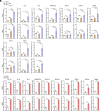Human airway and nasal organoids reveal escalating replicative fitness of SARS-CoV-2 emerging variants
- PMID: 37068258
- PMCID: PMC10151566
- DOI: 10.1073/pnas.2300376120
Human airway and nasal organoids reveal escalating replicative fitness of SARS-CoV-2 emerging variants
Abstract
The high transmissibility of SARS-CoV-2 Omicron subvariants was generally ascribed to immune escape. It remained unclear whether the emerging variants have gradually acquired replicative fitness in human respiratory epithelial cells. We sought to evaluate the replicative fitness of BA.5 and earlier variants in physiologically active respiratory organoids. BA.5 exhibited a dramatically increased replicative capacity and infectivity than B.1.1.529 and an ancestral strain wildtype (WT) in human nasal and airway organoids. BA.5 spike pseudovirus showed a significantly higher entry efficiency than that carrying WT or B.1.1.529 spike. Notably, we observed prominent syncytium formation in BA.5-infected nasal and airway organoids, albeit elusive in WT- and B.1.1.529-infected organoids. BA.5 spike-triggered syncytium formation was verified by lentiviral overexpression of spike in nasal organoids. Moreover, BA.5 replicated modestly in alveolar organoids, with a significantly lower titer than B.1.1.529 and WT. Collectively, the higher entry efficiency and fusogenic activity of BA.5 spike potentiated viral spread through syncytium formation in the human airway epithelium, leading to enhanced replicative fitness and immune evasion, whereas the attenuated replicative capacity of BA.5 in the alveolar organoids may account for its benign clinical manifestation.
Keywords: SARS-CoV-2; organoids; syncytium formation; viral fitness.
Conflict of interest statement
The authors have the following patent filings to disclose: 1) C.L., M.C.C., H.C., K.-y.Y., and J.Z. Airway organoids, methods of making and uses thereof. Publication No: US-2021-0207081-A1. 2) C.L., M.C.C., K.-y.Y., and J.Z. Alveolar organoids, methods of making and uses thereof (patent registration number: 63/238,486). 3) C.L., M.C.C., K.-y.Y., and J.Z. Human nasal organoids and methods of making and methods of use thereof (patent registration number: 63/358,795).
Figures






References
Publication types
MeSH terms
Substances
Supplementary concepts
LinkOut - more resources
Full Text Sources
Other Literature Sources
Medical
Miscellaneous

